ආයුබෝවන්
Ayubowan! May you live long!
Welcome to our blog about our Fulbright experience in Sri Lanka! We’re Dave and Dixie Damrel, resident here in Kandy at the University of Peradeniya for spring, 2019. Dave teaches Religious Studies at USC Upstate in Spartanburg, and Dixie is the curator of the Clemson University Herbarium. Here’s where you can get your Botany and Religious Studies needs taken care of in one handy blog!

What about Sri Lanka? It’s an island just slightly larger than South Carolina and with a population of over 23 million people. Since 1972 it has been called Sri Lanka, but before that it was Ceylon and even before that it was Sarandib. That’s where the word serendipity comes from, and we hope this blog will be serendipitous for you! Sri Lanka has a very old Buddhist community, and today over 70% of Sri Lankans speak Sinhalese (that’s where Ayubowan comes from) and follow a form of Theravadin (Hinayana) Buddhism. Mostly Hindu Tamil-speakers make up the rest of the population, and there are significant numbers of Muslims and Christians here too. The backgrounds of the people we’ve met don’t seem to matter — this is without a doubt one of the friendliest places you could ever hope to visit!
Floristically, it’s a dazzling mash-up of endemic tropical species combined with everything else south India, the Portuguese, the Dutch and then the British could add to the mix. There are over 4,000 native and naturalized flowering species of plants here (not even counting ferns and gymnosperms).
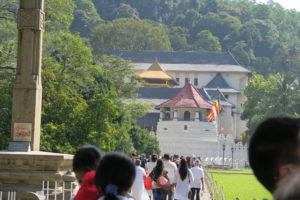
We’re based in the cooler, higher climate of Kandy, a beautiful green city often called the cultural center of the island. It’s a UNESCO World Heritage site of about 130,000 people and also home to the Buddhist pilgrimage shrine of the Temple of the Sacred Tooth Relic. We’ll talk about Buddhism, Hinduism, Islam and Christianity here later on.
Kandy is also home to the fabled Royal Botanic Garden at Peradeniya, one of the finest botanical gardens in Asia. Set in a crooked bend in the Mahaweli Ganga, the site had been pleasure gardens for centuries before British colonial authorities began to create formal gardens here in 1821. This is where Dixie will be working during our months here.
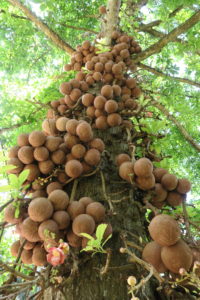
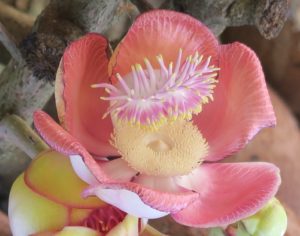
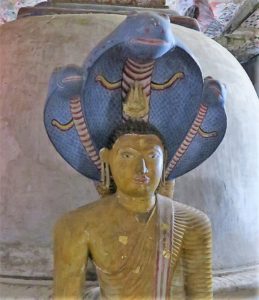
We’ll look at the gardens in much more detail later, but for now check out these magnificent “Cannonball Trees” (Couroupita guianensis) going great guns at this time of year in the garden. The flowers are beautiful and striking, and the fruits hang on racemes born directly on the trunk. This tree is considered sacred, due to the extraordinary structure of the flowers: two sets of stamens — one a ring in the center, and the other set forming a modified hood which some say resembles the hood of nagas (snakes) shading Lord Shiva’s head. It is grown in Hindu temples dedicated to Shiva, but also planted in many Buddhist temples and monasteries in Sri Lanka and other parts of Southeast Asia. In Buddhist tradition, Lord Buddha’s mother, Maya, held onto a blooming branch of a Sal tree (Shorea robusta), a tree native to Nepal, Burma and parts of India, while giving birth to him. For reasons now unclear (perhaps due to the flowers’ stunning beauty, or its “doctrine of signatures-like” naga hood stamens?) a Couroupita tree, introduced from South America into the Royal Botanical Garden here in 1881, was somehow mistaken for the Sal tree. This species then was planted in many temple courtyards in Sri Lanka, and can be seen today all across Buddhist Southeast Asia. Dr. D.S.A. Wijesundera, botanist, taxonomist and Director General of the Royal Botanical Garden in Kandy , recognized the mistaken identity and was instrumental in acquiring genuine Shorea robusta seeds to introduce into Sri Lanka. In 1980, visiting King Birendra and Queen Aishwarya of Nepal brought a Sal tree from the Buddha’s traditional birth-place and planted it in the Royal Botanical Garden here in Kandy. (We hope to have that image for a future blog!).
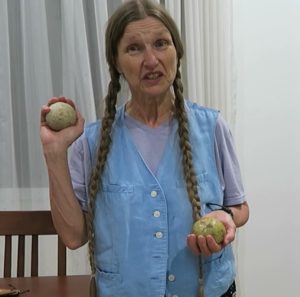
Using the “common” names to identify plants can often pose a perplexing pickle for a botanist. We just saw Exhibit A — the sacred Sal tree that was still sacred, but wasn’t a Sal Tree. Here’s Exhibit B. Two completely different plants commonly found in the markets here, and both are called both Wood Apple and Elephant Apple!
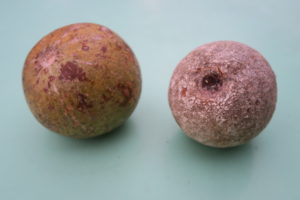
Here’s what they look like on the outside!

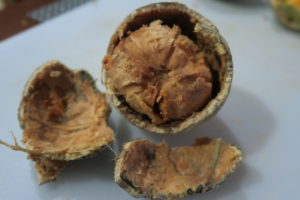
And here is what they look like on the inside!
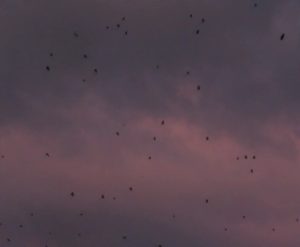
And finally, the bats! Every evening just at dusk the sky over our house fills with thousands of swirling fruit bats, pouring out of the forest and the Botanical Garden and passing over us on their way to eat. It coincides with the nightly pre-recorded hour-long broadcasts coming from the local Buddhist temples. Every night the amplified chants from the loudspeakers broadcast prayers calling for protection for the neighborhood, the nation and all sentient beings. Click on the image for a taste, and stay protected until the next blog post!

Delightful blog. Thanks for the education.the
Hi Dave and Dixie! I found this fascinating and will be looking forward to your blog posts. Love the pictures! Have you tasted the fruits called elephant (or wood) apples? They look as if they might be tasty, but the “smoked cheese aroma” made me wonder. It’s so fun to think of you in Kandy Kingdom — sounds like an app you would download to play an addictive, brightly colored game. 🙂 We’re enjoying Inki’s company, and for the past three nights, both cats have slept on our bed. They’re fairly far apart, but it represents progress! Sounds like you’re having fun, thanks for sharing so we can travel with you vicariously. Love, Karen
Great Blog Dave and Dixie!
I was beginning to think that a volcano or river monster had got you. Great blog and I look forward to reading more about all your adventures. Stay coo(?) in your warm weather as we enjoy 40 + or – days.
Hey, Russ! Thanx! We just finished blog 2 and will try to get blog 3 out sooner!
so glad to see this new blog it helps me get though the long Montana winter….so glad to see what a cannonball tree looks like.Those bats look like they are big and more bats than a baseball game
Thanks, Robin! I read recently that there are about 24,000 bats at the Botanical Garden that make the nightly rounds!
I like your blog😘
Thank you, Noel! Wish you were here!
Thank you so much for following on the blog. It means a lot to us!
This was great. Really enjoyed your blog and am looking forward to future editions!
Eric Astrachan
Tile Council of North America
100 Clemson Research Blvd.
Thanks so much, Eric!
This is fabulous – I am excited to keep up with your botanical adventures!
Thanks, Christina! Enjoy some tropical warmth on us!
Dixie, this is wonderful. I look forward to following your adventures and discoveries.
Thanks so much, Julie! We just posted entry #2, so hope you enjoy it! We’ll be a little quicker on entry 3!
Wonderful, it was a lovely 10 minute vacation for me. I’m looking forward to the next one. Happy travels.
Thanks for the positive feedback, Ed! Good vibes!
Hi Dave and Dixie, Steve clued me in that I had missed Dixie’s interesting video on the fruits; hence my clueless question about how they tasted, which she thoroughly answered! OK, now I have another question: Do elephants actually get any nutritional value from these rock-hard fruits, or do they just pass through their system? I’m thinking they would have to have extremely strong stomach acid to break them down. Not a botany question, so I don’t really expect an answer. Maybe I’ll google it. 🙂
Love, Karen
Hi Dixie and Dave! I love that I can still learn about botany from you even after graduating. I’ll be following along with your travels from Pennsylvania.
Hey Lucy! Thanks for following the blog! I’ve seen Clidemia hirta growing on our lane and trying to think of a way to get it to Dr. DeWalt! Hope you are doing super — great to hear from you! DZD